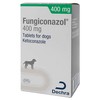Fungiconazol
Fungiconazol Tablets for Dogs are for the treatment of dermatomycoses due to the following dermatophytes: Microsporum Canis, Microsporum Gypseum, Trichophyton Mentagrophytes
Fungiconazol Tablets are round, flavoured tablets that are brown spiked in colour. They can be divided into halves and quarters for easy and accurate dosing.
Fungiconazol 200mg Tablets for Dogs
£1.97Fungiconazol 200mg Tablets are indicated for the treatment of dermatomycoses due to the following dermatophytes: Microsporum Canis Microsporum Gypseum Trichophyton Mentagrophytes ...[More info]
Fungiconazol 400mg Tablets for Dogs
£2.86Fungiconazol 400mg Tablets are indicated for the treatment of dermatomycoses due to the following dermatophytes: Microsporum Canis Microsporum Gypseum Trichophyton Mentagrophytes ...[More info]
Contraindications
Do not administer to animals with liver failure.
Do not use in cases of hypersensitivity to the active substance or to any of the excipients.
Special warnings for each target species
Although rare, repeated use of ketoconazole may induce cross-resistance to other azoles.
Special precautions for use in animals
Treatment with ketoconazole suppresses testosterone concentrations and increases progesterone concentrations and may affect breeding effectiveness in male dogs during and for some weeks after treatment.
Treatment of dermatophytosis should not be limited to treatment of the infected animal(s). It should also include disinfection of the environment, since spores can survive in the environment for long periods of time. Other measures such as frequent vacuuming, disinfection of grooming equipment and removal of all potentially contaminated material that cannot be disinfected will minimize the risk of re-infection or spread of infection.
Combination of systemic and topical treatment is recommended.
In case of long term treatment administration, liver function should be closely monitored. If clinical signs suggestive of liver dysfunction develop, treatment should be discontinued immediately. As the tablets are flavoured, they should be stored in a safe place out of the reach of animals.
Special precautions to be taken by the person administering the veterinary medicinal product to animals
Accidental ingestion should be avoided. Keep the blister in the outer carton to prevent access by children. Part (half/quarter) tablets should be stored in the original blister and be used for the next administration. In case of accidental ingestion, seek medical advice immediately and show the package leaflet or the label to the physician.
People with known hypersensitivity to ketoconazole should avoid contact with the veterinary medicinal product. Wash hands after use.
Other precautions
Dermatophytes mentioned in the indication have zoonotic potential with risk of transmission to humans. Maintain good personal hygiene (washing hands after handling the animal, and avoiding direct contact with animal). If signs of skin lesions occur, contact your physician.
Adverse reactions
In rare cases (more than 1 but less than 10 animals in 10,000 animals treated), neurological symptoms (apathy, ataxia, tremors), hepatic toxicity, vomiting, anorexia and/or diarrhoea may be observed at standard doses.
Ketoconazole has transient anti-androgen and anti-glucocorticoid effects; it inhibits the conversion of cholesterol to steroid hormones such as testosterone and cortisol in a dose dependent and time-dependent manner. See also Special precautions for use in animals for effects in male breeding dogs.
Use during pregnancy and lactation
Studies in laboratory animals have shown evidence of teratogenic and embryotoxic effects.
The safety of the product has not been established in pregnant or lactating bitches.
Use is not recommended during pregnancy.
Interactions
Do not administer with antacids and/or H2-receptor antagonists (cimetidine/rantidine) or proton pump inhibitors (e.g. omeprazole) as the absorption of ketoconazole may be modified (absorption requires an acid environment).
Ketoconazole is a substrate and potent inhibitor of cytochrome P450 3A4 (CYP3A4). It may decrease the elimination of drugs metabolized by CYP3A4, thereby altering their plasma concentrations. This may result in increased plasma concentrations of e.g. cyclosporine, macrocyclic lactones (ivermectin, selamectin, milbemycin), midazolam, cisapride, calcium-channel blocking agents, fentanyl, digoxin, macrolides, methylprednisolone or coumarine anticoagulants. The increased plasma levels of drugs mentioned above can prolong the duration of effects as well as side effects.
On the other hand, inducers of cytochrome P450 may increase the rate of metabolism of ketoconazole, e.g. barbiturates or phenytoin can increase the rate of metabolism of ketoconazole, resulting in a decreased bioavailability, hence a decreased efficacy.
Ketoconazole may decrease theophylline serum concentrations.
Ketoconazole inhibits the conversion of cholesterol to cortisol and may thus affect trilostane/mitotane dosing in dogs concurrently being treated for hyperadrenocorticism.
It is not known to what extent these interactions are relevant for dogs and cats, but in the absence of data, co-administration of the product and these drugs should be avoided.
Amounts to be administered and administration route
For oral use. 10 mg of ketoconazole per kg body weight daily, by oral administration. This corresponds to 1 tablet per 20 kg body weight daily.
It is recommended to sample the animal once a month during treatment and to stop antifungal administration after two negative cultures. When mycological follow up is not possible, treatment should be continued for an adequate period of time to ensure mycological cure. If lesions persist after 8 weeks of treatment, medication should be re-evaluated by the responsible veterinarian.
To be administered preferably together with food, in order to maximise absorption.
Tablets can be divided into halves or quarters to ensure accurate dosing. Put the tablet on a flat surface, with its scored side facing up and the convex (rounded) side facing the surface.
Halves: With the tip of the thumbs, exert a slight vertical pressure on both sides of the tablet to break it into halves.
Quarters: With the tip of a thumb, exert a slight vertical pressure on the middle of the tablet to break it into quarters.
Overdose
In cases of overdose the following effects may be seen: anorexia, vomiting, pruritus, alopecia and increase of hepatic alanine aminotransferase (ALT) and alkaline phosphatase (ALP).

